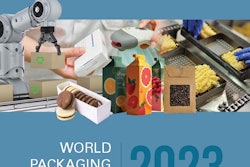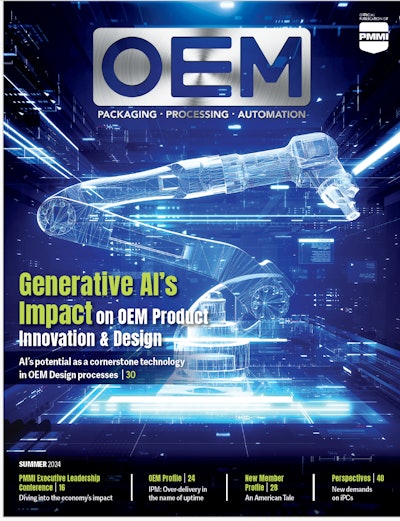In this episode, Jorge Izquierdo, vice president of market development for PMMI joins us for a deep dive into PMMI's latest reports on the world packaging machinery market and the guide to global markets which provide invaluable insights into market sizes, growth expectations, and detailed analyses of the packaging machinery import landscape. Tune in to hear not just numbers, but narratives that drive international market strategies. We'll explore the significance of sustainability, the digital revolution with Industry 4.0, and labor dynamics affecting the packaging industry.
Sean Riley:
So with all the fancy introductions out of the way, welcome to the podcast, Jorge.
Jorge Izquierdo:
Hey, Sean. Thank you very much for having me again. It's great to chat with you.
Sean Riley:
Yes, it's always a pleasure to have Jorge on the pod. Correct me if I'm wrong, but I'm pretty sure that PMMI's business intelligence has released a couple of reports recently sort of framing the size and the growth and having the general outlook of the global markets. Is that something you could speak to?
Jorge Izquierdo:
Absolutely, and you are totally right, Sean. We released two reports in the second quarter of 2023. One is talking about the world packaging machinery market. That one, it's the whole market size, talking about the different regions, growth, expectations in terms of which regions will be growing the fastest, which industries are dominating, and touching as well on some machinery categories.
The second report is the guide to global markets. That's a little more specific, much more in terms of imports of packaging machinery into each market. There's much more detail and granularity there. It's a great tool when you are making your plans. If you're in the packaging machinery business and you're trying to see what's the right market to go, where to put some more effort, it's a great report. And of course both reports are available at pmmi.org/research.
Sean Riley:
All right. Then with that in mind, after digging through the reports, what would you say are the top global trends that we're seeing in packaging?
Jorge Izquierdo:
Everybody knows sustainability is very relevant everywhere around the world. You can talk about developing, developed countries, Asia, Europe. Everywhere sustainability is very relevant.
And you can tie sustainability with also consumer expectations. So certainly it's both regulations and consumer expectations that are driving the change in packaging due to sustainability.
We can tell you that consumer expectation drive a lot of the flexibility, adaptation that we're always looking in packaging, switching different sizes, different formats, different opportunities for the consumers to use the products. And now all that flexibility that's looking about the size and shape, you need to add the materials, that flexibility, right? In many cases, a lot of things are moving towards more paper, less plastic. This evolution in materials is demanding a lot of flexibility from packaging equipment.
That would be, I guess, the number one, but the number two, it's no surprise either, it's digitalization. Everybody has been talking about Industry 4.0 and how you can use data to improve the productivity of your equipment.
And not just your equipment, it's also the whole journey of packaging, right? And a lot in terms of how to help identify materials in packaging, how to help their recovery and recyclability effort, more and more of that, really touching into things like data visibility of the day-to-day operation, but also looking into deep maintenance. That's something that used to be a little like science fiction a few years ago, now it's more like every day in many companies, and many companies are adopting it.
And I guess the next step we're starting to see more and more is the digital twins and how to take advantage of this technology and developing new projects, laying out the operations. So that's significant.
And I would say the last one that's very important when you're talking about the size of the market and the growth is labor. Globally, availability, cost and the skill gap of labor has a lot of implications. And there's significant connection as well between technology and availability, cost and the skill gap.
Many of these new technologies, when you talk about remote for example, it's about how to help the users of the packaging equipment, how to make the life easier for them, right? Even if they don't have an expert in the equipment, if the person operating the equipment is not at the top in terms of technical capabilities, the support that they can get remotely can improve significantly their ability to operate the equipment.
Sean Riley:
Interesting. Yeah, it's difficult to do a podcast and not have the labor issue come up. Because we're losing such a good portion of the skilled workforce as the baby boomers age out, it's interesting to learn that we're coming up with solutions that the next generation who might not have that acquired skills of decades and decades of working are going to be able to sort of jump right in and help out right away. That's interesting to hear.
Jorge Izquierdo:
That's for sure. And you're right, that's consistent everywhere.
Sean Riley:
All right. Well, then could you give us a general idea, I guess it's such a vast thing that I'm curious how you're going to nail it down, but you could give us a size of the global market for packaging machinery? And I guess with that in mind, what are the expectations for the next couple of years? Is it going to grow? Is it going to stay the same? What are we looking for?
Jorge Izquierdo:
Sure. Let me start by going back a couple of years, for sure 2021, 2022 were very years of significant growth for the industry everywhere. The changes in the way we consume products, and users as consumers, it was significant. There was significant growth in demand for packaging equipment.
So globally, 2021 should be around maybe 8% in terms of growth, 8, 9%. 2022 is one of the most significant growth that we have seen in a number of years since we estimate that the whole market grew 13% in 2022.
Sean Riley:
Wow.
Jorge Izquierdo:
And 2023, what we're finding, it's a slowdown. So after two years of significant amount of investment in packaging equipment, it's no surprise that things are starting to slow down. '24 we're expecting to be maybe not a contraction, a year of contraction, but a year of just zero growth, 2024. But again, it's the future, '25, '26, '27, they look pretty good, pretty reasonable. The expectation is for the market to keep growing.
Now, you were asking specifically about the size of the market. I haven't told you that. The size of the market, the total market globally for packaging machinery, it's estimated at around $46 billion. It will be growing in the next years, mainly 2025, 2027. And it's expected to reach around $58 billion, and that's the total market globally.
There's some regions of course that were expected that they will grow faster. Asia-Pacific, we think it's the one that will be growing the most. We're expecting it to grow around 6% a year, sorry, between '23 and '27. There's a lot of opportunities population-wise like growth, the disposable income. So there's a lot of reasons we are expecting Asia-Pacific to be the area that will be growing the most, is the largest, it's already.
The second largest is what we called Europe, Middle East and Africa, that part of the world, followed by the Americas. And all of them, there's expectation to grow, but for sure Asia-Pacific, it's the one that we think it's going to be growing the fastest.
Sean Riley:
Terrific. So with the humongous growth that we had '21 and '22, that was pretty much unsustainable, correct? It would've been, I don't want to say unsustainable, that's probably not the right word, but that would've been incredible to continue to grow at that rate?
Jorge Izquierdo:
Yeah, you're absolutely right. I can tell you, it was unbelievable how manufacturers of packaging equipment adapt to the situation. It was tough to be a manufacturer during COVID. Many of them adapted to the situation. They were able to push up their manufacturing operations.
A lot of effort. It was great. During those two years we saw delivery times going longer and longer because of the demand. But you're absolutely right, you cannot keep growing at that level forever. There's a limit. And again, we are finding now and a slowdown. And again, let me emphasize this, it's not contraction, it's a slowdown, and we will keep growing again as we expect, '25, '27. Yeah.
Sean Riley:
Yeah. That's what I wanted to note, that it's not a negative, it's just that we had to come down just a little bit because it was just unsustainable to have everyone churning out that much machinery [inaudible 00:09:04].
Jorge Izquierdo:
That's true. That's true, Sean.
Sean Riley:
All right. So I guess diving a little bit deeper into the markets themselves, which industries do you expect to dominate? I know you're probably going to say food and beverage, but are there some of the unsung ones that we don't usually hear about that might be popping up?
Jorge Izquierdo:
No, you're totally right. Food is by far the largest user of packaging. In terms of packaging equipment, it's consistent. We're expecting that around 40% of the market, packaging machine, will be going to the food industry. In 2027 that should be around %25 billion of equipment going to the food industry.
And you are right on the second one, the beverage industry, that expectation, and it's not surprise, just the amount of packaging used in both food and beverage is significant. For the beverage industry we're talking about maybe around 27% of the size of the market, so those two are going to remain there.
Certainly we are finding pharma, it's maybe growing kind of maybe at a faster pace, not the same size. We estimate pharma to be around 4.7 billion, just under the 5 billion, but still very significant, again, significant growth for the pharma industry in the Asia-Pacific region.
Sean Riley:
Okay. Interesting. Very interesting. Any particular reason why Asia-Pacific would be growing in the pharma?
Jorge Izquierdo:
I guess it has a lot to do with the population in general growing. When you look at what's happening for example in India and the disposable income in many of those countries increasing, they're having more and more access to these type of services and products. Yeah.
Sean Riley:
Mm-hmm. Interesting. Okay. Then I guess finally, we've talked about the markets and the overall size, but we haven't really dove into what about the machinery categories? Which ones of those are people sort of buying up the most? Which are those that we expect to grow the most?
Jorge Izquierdo:
That's a great question, Sean. I guess number one in general, it's filling and dosing I guess a lot of what we called primary packaging. That represents around maybe 20% of all the investment in packaging equipment.
The industry is looking for a lot of greater speeds, productivity, flexibility. And I guess primary packaging, it's the first step in the whole chain, country will be investing in primary packaging. A lot of investment as well in labeling, decorating, coding.
Part of this is related with quality, food and beverage, pharma. In all of those markets, it's very important to be able to trace where the problem is coming from. In case there's a problem, you're able to pull out the product from the market. And the more advanced technologies are available, the easier is to do this, and the easier is to make a clean cut in terms of where's the problem and limit the size of the recalls that you are forced to do. So that's very important and that's the second category that will be growing.
And then we have end of line. End of line, there's a little more segmentation there. End of line, the investment tend to be more on the developed side rather than the developing, a lot of it related with the cost of labor. But we are finding a significant investment in end of line on developed markets, and not just cost of labor. The other driver is e-commerce.
Traditionally, packaging equipment, it's been part of the packaging line. You produce a product and you pack the product and then you send it to the warehouses and you ship it. These days with e-commerce, warehouses are going through a transformation. It's not just pallets, forklifts and shipping the pallets, it's a lot of fulfillment right now. A lot of B2C, business-to-consumers, B2B. That means fulfillment of individual orders. That means case packing, sealing, labeling, a lot of mixed pallets going to specific stores or going to fulfill them by third parties.
So that's transformed significantly the warehouses, and significant opportunity growth for packaging equipment. And I was saying mainly and I guess at the beginning in the developed world, but more and more that will be moving into developing as well.
Sean Riley:
Interesting. And this just came, I was thinking of it when you were talking about the things like the coding and the marking being on the rise, would a lot of that be, we're seeing different regulations coming in in the US and in Europe and in different parts of the world, is that driving some of that need to have more coding and marking specifically on the equipment?
Jorge Izquierdo:
Absolutely. You can pretty much track the investment in labeling and coding equipment in different countries based on when they release new legislations.
These days, more and more they are actually, because of sustainability and traceability of the materials and being able to, again, to help with the classification of these materials, it's expected that the use of coding will increase significantly.
Sean Riley:
I guess that is all that I had to ask of you today. So I guess before we wrap up, if you might want to just remind everyone again where they can find these reports?
Jorge Izquierdo:
Yeah, absolutely. All our data is available in our website, our reports, data projections, pmmi.org/research. A lot of it is accessible for everybody in the industry. Full reports in general, they are available for members and also available for the rest of the public [inaudible 00:15:10].
Sean Riley:
That's fantastic. Thank you for taking time out of your day to come on here, Jorge, and sort of walk us through these reports.
Jorge Izquierdo:
And Sean, always nice chatting with you. Hope to see you soon



















